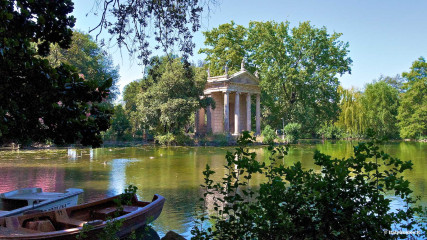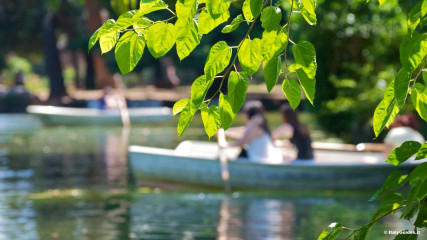Stretching from above Piazza del Popolo to the top of Via Veneto, Villa Borghese crowns Rome in a glorious canopy of Green. Despite the onward march of the years and extensive developmental changes to Rome, Villa Borghese has remained a green and pleasant space, diluting the impact of an otherwise ever expanding urban Metropolis.
Villa Borghese is literally a breath of fresh air for those who visit it. There are museums (Borghese Gallery), a theatre, a bio park, a lake, a winter ice skating piste, rollerblade and skateboarders space as well as numerous fountains dotted throughout.
The Park was originally a private vineyard, redesigned and enlarged in 1605 to grandiose proportions for pope Paul V's nephew, the Cardinal Scipione Borghese. However, it was named after the Borghese family on the condition that it boasted the most luxurious and magnificent dwelling in Rome.
The art museum in the park, was originally designed not only to house the Cardinal's art collection, but also to be a "villa of delights". Various architects, including the Dutch designer Jan Van Staten, known to Italians as Vasanzio and the garden designer Jerome Rainaldi, participated in its creation. The Park was divided into three sections: the first was to be wooded, the second, more artistic, with statues, sculptures and perspectives, and the third more wild and "natural".
The Secret Garden, is a charming characteristic which can be found in italian parks and gardens of the Renaissance and Baroque periods, when there was a revival of interest in all things ancient. These lovely enclosed spaces, often near their owners' homes, were reserved for the invited and the privileged. Such places have a lovely atmosphere of seclusion, secrecy and tranquility, adding new dimensions of beauty to their surroundings.
Villa Borghese had two “secret spaces”: one, shrouded by trees, is the garden of bitter oranges “Giardino dei melangoli” and has a lovely eagle fountain in front of its adjacent mansion; the second “The Flower Garden”, is the beautifully laid out formal garden. A third secret garden stretches in front of the Aviary, accompanied by the Meridiana (Sun dial) mansion, designed by Rainaldi.
The Secret Gardens are not the only charming corners of Villa Borghese: the Valley of Plain Trees, Piazza di Siena and the Gardens of Muro Torto as well as the Bio Park, which was added later, make it a wonderful place to explore.
In the Seventeen Hundreds, after a major expansion and restoration project in the park, the Lake Garden was added to the Valley of the Plain trees by the English designer Jacob Moore. In the same years were built the fake Roman ruins of the Temple of Faustina, the Temple of Diana, and the Clock Building (Casino dell'Orologio) and Piazza di Siena was set up.
In the Eighteen Hundreds Luigi Canina embellished Villa Borghese, redesigning the entrance near Piazza del Popolo. In the same year Camillo Borghese, Napoleon Bonaparte's brother in law, transfered much of the splendid art collection in the Villa to Paris.
Because the Borghese family opened this essentially private park to the public every sunday and on public holidays, Villa Borghese has always been dear to Romans.
During the Nineteenth Century it became a centre for festivals and public events, often with flamboyant and colorful firework displays and water games in the fountains or on the lake. As it is a pleasant place to stroll on a fine day, it became a favorite place for leisure time, with the possibility of a spot of boating (for a small fee) or a visit to the trattoria.
The famous Roman poet Gioachino Belli (whose statue, complete with top hat, stands in Trastevere) celebrated Villa Borghese in the words: «Long live the heart of Prince Borghese».
The park had truly evolved into a place for leisure and pleasure. This private park for the aristocracy, and at the same time, playground for the people, became a focal point of the city both for the haves and the have nots.
The numerous birds in the Aviary, the wild and exotic animals which roamed the park, even before the Bio Park was built, and the special making of icy drinks and sorbets in summer with " snow preserves" all made it enormously popular.
Villa Borghese's fame also stretched beyond Rome's walls. The Borghese family hosted and patronized numerous noble and noted european figures, including Goethe and Stendhal, raising Villa Borghese's profile and ensuring its inclusion on the list of must sees of the Grand Tour.
At the dawn of the Twentieth Century, after a long dispute with the Borghese family, the Italian State bought the park, which was then bestowed on the Rome City Council, and opened "full time" to the public.
Although the Villa was then named after the murdered king Umberto I, in affectionate memory of its roots, Romans continued to call it Villa Borghese.
Villa Borghese remains one of Rome's abiding pleasures and attractions for Romans and visitors alike. Being ideal venue for musical concerts, there are many throughout the summer season. The intimate and charming cinema there, was entered in the Guinness book of Records as the world's smallest picture house, converted from an old bar. The Restaurants, and the wonderful replica of London's Shakespearean Globe Theatre, are also well worth a visit.
The peace, graceful trees, relaxing fountains, romantic walkways, evocative views of the city set off to perfection at sundown, the lake and secret gardens make it the perfect spot for a summer afternoon.
In the panoramic photo at the top of the page you can see the Temple of Diana. Although it recalls the buildings of ancient times, the temple, situated in Viale della Casina di Raffaello, was built in 1789, as an adjunct of the Villa.
Originally it contained an ancient statue of the goddess of hunting.















